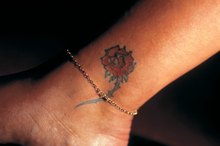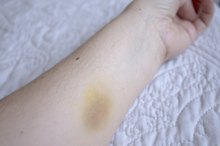How to Reduce Ankle Sprain Swelling
An ankle sprain refers to an injury to one or more of the ligaments on the outer portion of the ankle 3. Ankle sprains can range in severity from mild ligament stretching to more serious ligament tearing. Swelling and pain frequently accompany an ankle sprain 14. Treating these symptoms can reduce your symptoms and minimize ankle instability that can occur after an ankle sprain.
If you are experiencing serious medical symptoms, seek emergency treatment immediately.
Rest the ankle immediately following injury to prevent further swelling and allow the ligaments to heal. While the amount of rest required may vary from person to person, rest the ankle until swelling is all or nearly gone and the ankle is not tender to the touch.
How to Treat Shin Splints
Learn More
Apply an ice pack to the ankle. Ice or cold therapy constricts blood vessels and reduces swelling. Be sure to cover the ice pack with a protective cloth or plastic bag in order to prevent cold burns. Leave the ice pack on for 10 to 15 minutes at a time, every three to four hours. Continue for two to three days after injury.
Elevate the foot above the heart for 48 hours after injury to reduce swelling in your ankle. Use several comfortable pillows or another prop to keep the foot elevated.
How to Care for a Tattoo on Your Ankle
Learn More
Wrap your ankle with an elastic compression wrap to reduce swelling. Leave one finger-width between the wrap and your skin to avoid wrapping too tightly. Wear the wrap while you are awake.
Take a nonsteroidal anti-inflammatory medication, or NSAID, such as ibuprofen (Advil, Motrin) or naproxen (Naprosyn, Aleve) to reduce inflammation. Use only as directed.
Tips
During the first 24 hours after injury, avoid the following activities: taking a hot shower, using heat rubs, applying a heating pad or drinking alcohol. Consult your doctor before you take aspirin -- it can thin your blood and cause bleeding.
Warnings
Seek medical attention if you can't bear weight on your leg, or you can't move your ankle after injury.
Related Articles
References
- American Academy of Orthopaedic Surgeons: Sprained Ankle
- American Family Physician: Update on Acute Ankle Sprains
- Sports Injury Clinic: Treatment of a Sprained Ankle
- American College of Foot and Ankle Surgeons: Ankle Sprain
- Martin R, McGovern R. Managing ankle ligament sprains and tears: current opinion. Open Access J Sports Med. 2016;7:33-42. doi:10.2147/oajsm.s72334
- American Academy of Orthopaedic Surgeons. Sprained Ankle. Updated February 2016.
- Khor YP, Tan KJ. The Anatomic Pattern of Injuries in Acute Inversion Ankle Sprains: A Magnetic Resonance Imaging Study. Orthop J Sports Med. 2013;1(7):2325967113517078. doi:10.1177/2325967113517078
- Dewar RA, Arnold GP, Wang W, Drew TS, Abboud RJ. The effects of wearing an Ankle Stabilizing Orthosis (ASO) Ankle Brace on ankle joints kinetics and kinematics during a basketball rebounding task.Foot (Edinb). 2019 May 7;40:34-38. doi: 10.1016/j.foot.2019.05.003. [Epub ahead of print]
- Mun JU, Cho HR, Sung YJ, Kang KN, Lee J, Joo Y et al. The role of the anterior talofibular ligament area as a morphological parameter of the chronic ankle sprain.J Orthop Sci. 2019 May 16. pii: S0949-2658(19)30129-0. doi: 10.1016/j.jos.2019.05.001. [Epub ahead of print]
Writer Bio
Rachel Nall began writing in 2003. She is a former managing editor for custom health publications, including physician journals. She has written for The Associated Press and "Jezebel," "Charleston," "Chatter" and "Reach" magazines. Nall is currently pursuing her Bachelor of Science in Nursing at the University of Tennessee.









